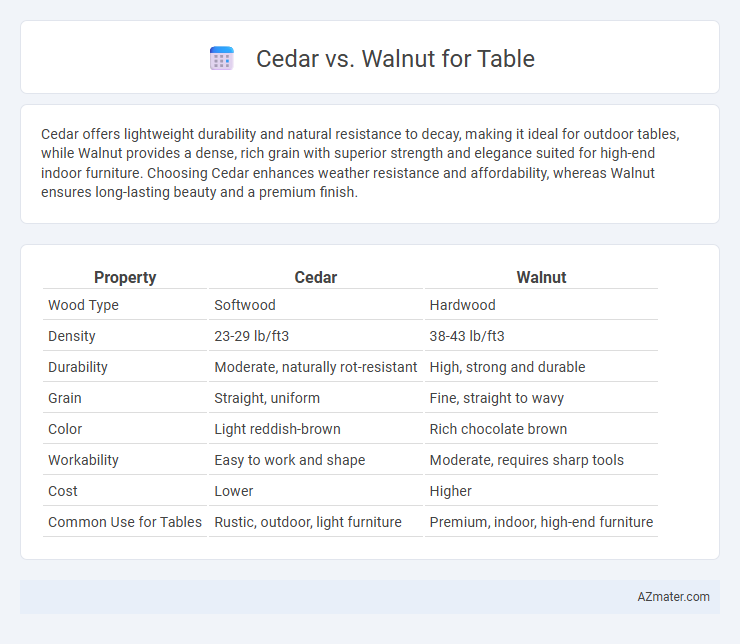Cedar offers lightweight durability and natural resistance to decay, making it ideal for outdoor tables, while Walnut provides a dense, rich grain with superior strength and elegance suited for high-end indoor furniture. Choosing Cedar enhances weather resistance and affordability, whereas Walnut ensures long-lasting beauty and a premium finish.
Table of Comparison
| Property | Cedar | Walnut |
|---|---|---|
| Wood Type | Softwood | Hardwood |
| Density | 23-29 lb/ft3 | 38-43 lb/ft3 |
| Durability | Moderate, naturally rot-resistant | High, strong and durable |
| Grain | Straight, uniform | Fine, straight to wavy |
| Color | Light reddish-brown | Rich chocolate brown |
| Workability | Easy to work and shape | Moderate, requires sharp tools |
| Cost | Lower | Higher |
| Common Use for Tables | Rustic, outdoor, light furniture | Premium, indoor, high-end furniture |
Introduction to Cedar and Walnut Wood
Cedar wood is valued for its lightweight, aromatic properties, and natural resistance to moisture and insects, making it ideal for outdoor and rustic furniture. Walnut wood is prized for its rich, dark color, exceptional strength, and fine grain, offering durability and a luxurious appearance for high-end tables. Both woods present unique characteristics that influence aesthetics and functionality in table design.
Key Differences in Appearance
Cedar features a lighter, reddish-brown hue with a distinctive straight grain and natural knots that create a rustic, warm aesthetic ideal for casual or outdoor tables. Walnut exhibits a darker, rich chocolate brown color with a smooth, fine grain and occasional swirling patterns, offering a sophisticated, elegant look suited for formal settings. The contrast in wood tone and grain complexity makes cedar better for natural, earthy designs, while walnut emphasizes luxury and refinement in table craftsmanship.
Durability and Longevity Comparison
Walnut offers greater durability and longevity compared to cedar, with a Janka hardness rating of approximately 1,010, making it more resistant to dents and wear. Cedar, with a softer texture and a Janka rating around 350, is more prone to scratches and dents but provides natural resistance to decay and insects, enhancing its lifespan in specific conditions. For table construction, walnut's robust hardness and dense grain structure ensure a longer-lasting surface better suited for heavy daily use.
Workability and Ease of Crafting
Cedar offers exceptional workability due to its lightweight and soft texture, making it easy to cut, shape, and sand, ideal for detailed craftsmanship and beginner woodworkers. Walnut, though denser and harder, provides a smooth finish and carves beautifully with sharp tools, favored for fine joinery and intricate designs by experienced artisans. Both woods respond well to hand and power tools, but cedar's softness reduces tool wear, while walnut's hardness demands sharper blades and more effort for precise detailing.
Resistance to Decay and Insects
Cedar is naturally resistant to decay and insect infestation due to its oils and chemical compounds, making it ideal for outdoor tables exposed to moisture and pests. Walnut, while durable and strong, lacks the same inherent resistance and may require additional treatments to protect against rot and insect damage. For long-lasting outdoor furniture, cedar offers superior protection against environmental threats compared to walnut.
Cost and Availability
Walnut tables typically have a higher cost due to the wood's rich appearance and slower growth, while cedar offers a more budget-friendly option with its faster availability and regeneration. Walnut is less abundant and often sourced from sustainable forests, making it pricier and sometimes limited in supply. Cedar is widely available, especially in North America, providing an economical choice for table construction without compromising durability.
Eco-Friendliness and Sustainability
Cedar is a highly sustainable wood due to its fast growth and natural resistance to pests and decay, reducing the need for chemical treatments and promoting eco-friendly furniture production. Walnut, although slower growing, is often sourced from responsibly managed forests where selective harvesting ensures the long-term health of ecosystems. Choosing cedar over walnut for tables supports lower environmental impact through quicker renewability and less intensive resource use, making it a preferable option for eco-conscious consumers.
Maintenance and Care Requirements
Cedar tables require regular sealing to maintain resistance against moisture and prevent warping, with occasional oiling recommended to preserve natural oils and color. Walnut tables demand less frequent sealing but benefit from periodic cleaning and conditioning with specialized wood oils to protect their rich, dark finish and prevent drying or cracking. Both woods should be kept away from direct sunlight and extreme humidity to extend their lifespan and maintain aesthetic appeal.
Ideal Uses for Cedar Tables vs Walnut Tables
Cedar tables are ideal for outdoor or rustic settings due to their natural resistance to moisture, decay, and insects, making them perfect for patios, garden furniture, or cabins. Walnut tables excel in indoor environments where durability and rich, dark grain patterns enhance dining rooms, offices, or formal living spaces, offering a luxurious and elegant aesthetic. Choosing between cedar and walnut depends on whether exposure to elements or refined interior style is the priority.
Choosing the Right Wood for Your Table
Choosing the right wood for your table involves understanding the distinct qualities of cedar and walnut. Cedar offers a lightweight, aromatic wood with natural resistance to moisture and insects, making it ideal for outdoor or rustic tables. Walnut, prized for its rich, deep brown color and durability, provides a smooth finish and sophisticated look suited for indoor furniture and heirloom-quality pieces.

Infographic: Cedar vs Walnut for Table
 azmater.com
azmater.com